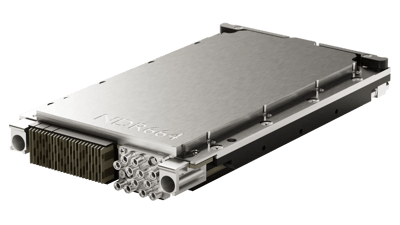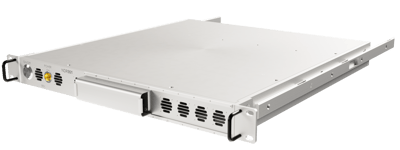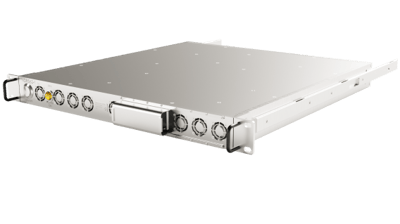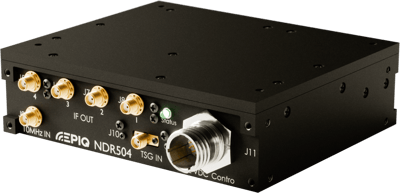Breaking Through the 6 GHz Ceiling
John Orlando
04/13/21

The vast majority of RF devices you can buy today utilize RF spectrum at frequencies below 6 GHz. Everything from the cell phones in our pockets, the Wi-Fi® routers in our homes, the Bluetooth® health trackers on our wrists, the wireless garage door openers in our cars, and even FM radio (do people still listen to FM radio???)...all of these devices use radio waves that occupy small chunks of highly sought after RF spectrum below 6 GHz for their use. Since the sub-6 GHz frequency sweet spot covers the vast majority of the radio use-cases used by typical consumers, most integrated RFIC vendors have focused on supporting wireless device operation below 6 GHz. And there is a virtuous cycle: the more consumers use devices at these RF frequencies, the better the business case for RFIC and component vendors to develop hardware to support these frequencies, which then drives device price down, which in turn increases the attractiveness of these devices, which creates more consumers, and so on. Such has been the case for several decades.
But now, both industry and government are making bold moves and taking aim at utilizing the spectrum beyond the 6 GHz threshold. In 2019, communications companies formally launched 5G cellular systems using millimeter wave frequencies from 24 GHz up to 52.6 GHz in the so-called “FR2” band. This band allows for incredibly fast internet access in excess of 1 Gbit/sec from a mobile device, though it typically requires a clear line of sight to a cell tower due to signal propagation challenges at these higher RF frequencies. And just last year, the Federal Communications Commission (FCC) made history by releasing new bandwidth for Wi-Fi up to 7.125GHz in the first Wi-Fi spectrum upgrade in 17 years. RF frequencies that were previously reserved for military and satellite applications are now opening up more to commercial applications in a move that has been described as a watershed moment for innovation that will supercharge connectivity in basically all application areas such as remote education, telemedicine, work, commerce, gaming, and social media.
The RF spectrum above 6 GHz presents some very compelling opportunities, from Wi-Fi to satellite communications to Gbit/sec mobile internet, and is attracting investment and development by engineering teams to ensure there is hardware ready to support operation at these frequencies as the application and usage landscape continues to broaden.
The Challenges of Operating Above 6 GHz
With all the possibilities that 6 GHz presents, it would be easy to question why this spectrum wasn’t being used sooner. In fact, there are several reasons that development in RF technology above 6 GHz has been slow. Some of these are economic in nature. Few commercial applications could use that spectral range, which significantly limited commercial investment made in 6 GHz research and development. However, this is rapidly changing as the FCC allocates more of this spectrum for commercial purposes.
While economics are becoming less of a barrier, the technical challenges of RF solutions above 6 GHz remain significant. As stated earlier, as RF frequency increases, signal attenuation is a serious concern. Air density and even rainwater droplets can affect signal propagation, making long-distance transmission challenging without significant increases in RF power and/or the need for specialized antennas to increase the RF gain. Table 1 shows the typical attenuation of various RF frequencies when traveling over a distance of 1000 meters.
|
RF Frequency |
Free-Space Path Loss (at 1000 meters) |
|
100 MHz (FM radio) |
72 dB |
|
600 MHz (5G FR1 cellular) |
88 dB |
|
2.4 GHz (Wi-Fi) |
100 dB |
|
5 GHz (W-Fi) |
106 dB |
|
18 GHz (satellite communications) |
118 dB |
|
28 GHz (5G FR2 cellular) |
121 dB |
|
39 GHz (5G FR2 cellular) |
124 dB |
Table 1: Typical free-space path loss of common RF signals at a distance of 1000 meters
The Hardware Making It Possible
With additional applications and use cases growing each year for RF spectrum access above 6 GHz, the pressure to innovate RFIC and component technology in small form factors has also been ramping up. The RF components needed to enable an RF block conversion solution have been available for years. A typical architecture used to provide access to RF frequencies above 6 GHz (while leveraging existing investments in sub-6 GHz hardware) is shown in Figure 1. This topology utilizes a first stage RF block downconverter for receive applications, or upconverter for transmit applications. The block converter hardware is responsible for performing all of the necessary RF conditioning (amplification, filtering, etc) as well as mixing to convert an RF signal above 6 GHz to an intermediate frequency below 6 GHz. Once it is at this intermediate frequency below 6 GHz, more traditional RF transceiver solutions can be utilized to access and process the signal, thus leveraging previous investment.

Figure 1: Simplified RF block conversion architecture with a sub-6 GHz SDR
The hardware for these components has historically been very expensive, power hungry, and often considered impractical for the more desirable small form factor systems. But rapid progress has been made in this space in the past three years. There are multiple vendors who sell broad market low-noise amplifiers (LNAs) and RF pre-select filter solutions that cover the 6-18 GHz range and above. Similarly, RF mixers and the requisite RF local oscillator (LO) source needed to implement a block conversion approach are also readily available for integration. A complete single channel RF block downconversion solution capable of converting from an RF frequency of 6-18 GHz to an intermediate frequency (IF) of 3 GHz can be realized in less than 3 watts of power consumption. Similarly, an RF block downconversion solution capable of converting between 24-40 GHz and an intermediate frequency of 3 GHz can also be realized with under 3 watts of power consumption. Each of these modules can be achieved with just a few square inches of circuitry, thus enabling both portable applications as well as multi-channel (MIMO) operation within a reasonable power envelope.
Where to Next?
The holy grail is direct sampling at RF frequencies above 6 GHz, thus eliminating the need for even the RF block conversion circuitry, which simplifies commonplace analog hardware issues with RF mixing spurs and management of harmonics. Several data converter vendors have solutions that are capable of directly sampling RF signals above 6 GHz today. These systems still require the proper amplification and RF filtering to be utilized in the real world, and, of course, power consumption is still challenging with such high data rate converters. This technology will continue to progress in the coming years, power consumption will get further reduced with smaller and smaller semiconductor nodes being utilized, and eventually direct sampling solutions will be viable. For the foreseeable future, however, RF block conversion provides a very attractive balance of leveraging previous investment, performance, low power consumption, and small physical size to enable access of RF frequencies between 6-18 GHz and beyond.
Epiq Solutions is an established leader in RF technology and applications. Our products help ensure the safety and security of the airwaves for customers across a broad range of security applications. If you find yourself contemplating the best approach to extending the RF frequency range of your small form factor SDR-based system or your next 3U VPX card to reach above 6 GHz, drop our team a line. We have been investing significant resources in this space, and would be happy to talk through options for your application.
SHARE
Tags
STAY INFORMED
Stay up to date with the latest Epiq news, product releases, and more.












.webp?length=400&name=Cyber-Radio-NDR585%20(3).webp)


















.webp?width=70&height=70&name=Vector%20(1).webp)


